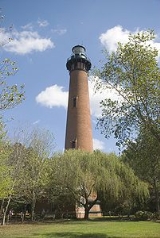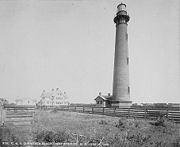
Currituck Beach Light
Encyclopedia
The Currituck Beach Light is a lighthouse
located on the Outer Banks
in Corolla
, North Carolina
. An example of Gothic Revival architecture
, the Currituck Beach Light was added to the National Register of Historic Places
on October 15, 1973.
with the Bureau of Lighthouses.
The Outer Banks Conservationists (OBC) performed much of the reconstruction and refurbishing work since 1980 through private funding and volunteer work. Since 1991 visitors have been allowed to climb the original 214 steps to the outdoor gallery. Access to the lens room is not permitted as the first order lens is not only the original lens, but it is still a functioning one. The light comes on every night and shines from 158 feet (48.2 m) at 20-second intervals to warn ships hugging the chain of barrier islands along the coast.
In 2003 the Federal Government granted OBC the title to the lighthouse itself. The Coast Guard approved OBC’s ownership proposal over that of an application submitted by Currituck County
(the county in which the lighthouse is located). Through state and federal legislative maneuvering, the county sued OBC to try to acquire the property. The case was finally settled in 2006. OBC remains the owner of the Currituck Beach Lighthouse.
 As it had reported in previous years, the U.S. Light-House Board in 1872 stated that ships, cargoes, and lives continued to be lost along the 40 miles (64.4 km) of dark coastline that lay beyond the reaches of existing lighthouses. Southbound ships sailing closer to shore to avoid the Gulf Stream
As it had reported in previous years, the U.S. Light-House Board in 1872 stated that ships, cargoes, and lives continued to be lost along the 40 miles (64.4 km) of dark coastline that lay beyond the reaches of existing lighthouses. Southbound ships sailing closer to shore to avoid the Gulf Stream
were especially in danger. In response, construction began on the Currituck Beach Lighthouse in 1873 with completion two years later.
The Currituck Beach Lighthouse is a first order lighthouse, meaning it has the largest of seven Fresnel lens
sizes. The original source of light was a Funck's hydraulic float lamp, fueled with lard oil, and consisting of four concentric wicks. In approximately 1884, the lighthouse converted to a mineral oil (kerosene) lamp with five concentric wicks; the largest was 4 inches in diameter. By 1913, an incandescent oil vapor lamp was used, with kerosene vaporized and forced into the burner by use of a hand pump attached to the storage tank.
Before the advent of electricity, a mechanical means was required to rotate the huge lenses that made the light appear to flash. A system of weights suspended from a line powered a clockwork mechanism beneath the lantern—much like the workings of a grandfather clock. The keeper cranked the weights up by hand every two and a half hours.
Like the other lighthouses on North Carolina's Outer Banks, this one still serves as an aid to navigation. The beacon comes on automatically every evening at dusk and ceases at dawn.
With a 20-second flash cycle (on for 3 seconds, off for 17 seconds), the light can be seen for 18 nautical miles (33.3 km). The distinctive sequence enables the lighthouse not only to warn mariners but also to help identify their locations.
The Currituck Beach Lighthouse was the last major brick lighthouse built on the Outer Banks.
Sand Island Light (Alabama) was built in 1873 using the same plans as Currituck Beach Light, but with a second order Fresnel lens.
, two cisterns that store rain water, and a storage building used as an office.
Lighthouse
A lighthouse is a tower, building, or other type of structure designed to emit light from a system of lamps and lenses or, in older times, from a fire, and used as an aid to navigation for maritime pilots at sea or on inland waterways....
located on the Outer Banks
Outer Banks
The Outer Banks is a 200-mile long string of narrow barrier islands off the coast of North Carolina, beginning in the southeastern corner of Virginia Beach on the east coast of the United States....
in Corolla
Corolla, North Carolina
Corolla is an unincorporated community located in Poplar Branch township, Currituck County, North Carolina along the northern Outer Banks. It has a permanent population of approximately 500 people; during the summer vacation season, the population surges into the thousands...
, North Carolina
North Carolina
North Carolina is a state located in the southeastern United States. The state borders South Carolina and Georgia to the south, Tennessee to the west and Virginia to the north. North Carolina contains 100 counties. Its capital is Raleigh, and its largest city is Charlotte...
. An example of Gothic Revival architecture
Gothic Revival architecture
The Gothic Revival is an architectural movement that began in the 1740s in England...
, the Currituck Beach Light was added to the National Register of Historic Places
National Register of Historic Places
The National Register of Historic Places is the United States government's official list of districts, sites, buildings, structures, and objects deemed worthy of preservation...
on October 15, 1973.
History
On December 1, 1875, the Currituck Beach Light was completed, located between Cape Henry Light and Bodie Island. Unlike its fellows, Currituck Beach Light was not painted, leaving its brick facade visible. In 1939, the lighthouse was automated following a merger of the United States Coast GuardUnited States Coast Guard
The United States Coast Guard is a branch of the United States Armed Forces and one of the seven U.S. uniformed services. The Coast Guard is a maritime, military, multi-mission service unique among the military branches for having a maritime law enforcement mission and a federal regulatory agency...
with the Bureau of Lighthouses.
The Outer Banks Conservationists (OBC) performed much of the reconstruction and refurbishing work since 1980 through private funding and volunteer work. Since 1991 visitors have been allowed to climb the original 214 steps to the outdoor gallery. Access to the lens room is not permitted as the first order lens is not only the original lens, but it is still a functioning one. The light comes on every night and shines from 158 feet (48.2 m) at 20-second intervals to warn ships hugging the chain of barrier islands along the coast.
In 2003 the Federal Government granted OBC the title to the lighthouse itself. The Coast Guard approved OBC’s ownership proposal over that of an application submitted by Currituck County
Currituck County, North Carolina
-National protected areas:*Currituck National Wildlife Refuge*Mackay Island National Wildlife Refuge -Demographics:As of the census of 2010, there were 23,547 people, 6,902 households, and 5,204 families residing in the county. The population density was 70 people per square mile . There were...
(the county in which the lighthouse is located). Through state and federal legislative maneuvering, the county sued OBC to try to acquire the property. The case was finally settled in 2006. OBC remains the owner of the Currituck Beach Lighthouse.
Facts
- Number of steps: 214
- Height to focal plane of lens: 158 feet (48.2 m)
- Height to top of roof: 162 feet (49.4 m)
- Number of bricks: approximately one million
- Thickness of wall at base: 5 feet 8 inches (1.7 m)
- Thickness of wall at parapet: 3 feet (0.9 m)
- Position: 34 miles (54.7 km) south of the Cape Henry (Virginia) Lighthouse; 32½ miles (52.3 km) north-northwest of Bodie Island Lighthouse
- Coast Survey Chart: 36° 22'36" N latitude, 75° 49'51" W longitude.

Gulf Stream
The Gulf Stream, together with its northern extension towards Europe, the North Atlantic Drift, is a powerful, warm, and swift Atlantic ocean current that originates at the tip of Florida, and follows the eastern coastlines of the United States and Newfoundland before crossing the Atlantic Ocean...
were especially in danger. In response, construction began on the Currituck Beach Lighthouse in 1873 with completion two years later.
The Currituck Beach Lighthouse is a first order lighthouse, meaning it has the largest of seven Fresnel lens
Fresnel lens
A Fresnel lens is a type of lens originally developed by French physicist Augustin-Jean Fresnel for lighthouses.The design allows the construction of lenses of large aperture and short focal length without the mass and volume of material that would be required by a lens of conventional design...
sizes. The original source of light was a Funck's hydraulic float lamp, fueled with lard oil, and consisting of four concentric wicks. In approximately 1884, the lighthouse converted to a mineral oil (kerosene) lamp with five concentric wicks; the largest was 4 inches in diameter. By 1913, an incandescent oil vapor lamp was used, with kerosene vaporized and forced into the burner by use of a hand pump attached to the storage tank.
Before the advent of electricity, a mechanical means was required to rotate the huge lenses that made the light appear to flash. A system of weights suspended from a line powered a clockwork mechanism beneath the lantern—much like the workings of a grandfather clock. The keeper cranked the weights up by hand every two and a half hours.
Like the other lighthouses on North Carolina's Outer Banks, this one still serves as an aid to navigation. The beacon comes on automatically every evening at dusk and ceases at dawn.
With a 20-second flash cycle (on for 3 seconds, off for 17 seconds), the light can be seen for 18 nautical miles (33.3 km). The distinctive sequence enables the lighthouse not only to warn mariners but also to help identify their locations.
The Currituck Beach Lighthouse was the last major brick lighthouse built on the Outer Banks.
Sand Island Light (Alabama) was built in 1873 using the same plans as Currituck Beach Light, but with a second order Fresnel lens.
Timeline
Currituck Beach Lighthouse Compound
The Outer Banks Conservationists work to restore and maintain the lighthouse and buildings on the compound. Visitors can climb the lighthouse daily from Easter through Thanksgiving. A small house, possibly a residence for a third keeper and his family, has been restored for use as a museum shop. The exterior of the larger Keeper's House has been restored, but work continues on the interior. Other structures on the compound include a two-hole privyOuthouse
An outhouse is a small structure separate from a main building which often contained a simple toilet and may possibly also be used for housing animals and storage.- Terminology :...
, two cisterns that store rain water, and a storage building used as an office.
Currituck Beach Lighthouse Lightkeepers and their Families
- Captain Nathan Swain and Francis Slice Swain (1905 -1920)
- Loren Tillet (1921- )

